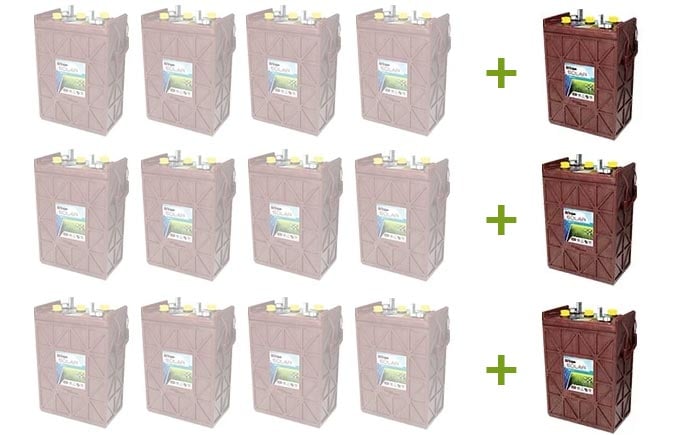As careful as you were to properly size the deep cycle battery bank for your renewable energy system, things change sometimes. If you’ve added some new appliances, purchased an electric vehicle, or have more people living in the house now than when you first planned and installed your system, your batteries may not be able to keep up with your new energy demands. You might be wondering how to expand that deep cycle battery bank.
Can I Add New Deep Cycle Batteries to an Existing Bank?
Yes – but it’s important to consider whether you should. Most battery manufacturers and experts (including us) state that it is not recommended to connect new batteries to batteries that have already been cycling regularly. The reasons for this are not about safety – they’re about practicality and cost.
Batteries wear out over time. Their capacity slowly degrades the more often and more deeply they cycle. When you connect brand new batteries to used batteries of the same model (never mix and match batteries that aren’t identical in the same bank), the new ones inherit the capacity of the used ones since they must all charge and discharge in unison. So unless your current batteries are only lightly used and are providing nearly 100% of their rated capacity, you will miss out on some of the capacity of the new batteries you buy for expansion.
But keep reading – if you plan to go ahead with expanding your existing deep cycle battery bank, there’s more to know.
Expanding a Lead Acid Deep Cycle Battery Bank
Adding to a lead acid battery bank (either flooded or sealed/AGM) should be done within about 6 months of starting regular use. Flooded lead acid batteries in particular degrade quickly as deep cycle batteries go, so the window of expanding while they’re at or near full capacity is short.
If you’re past 6 months already and need more storage, replacing your lead acid batteries with lithium solar batteries is a great solution. Using the same amount of physical space, lithium batteries offer double the capacity (or more) of lead acid – meaning a brand new and much bigger battery bank can fit on the same shelf or in the same enclosure as the old one.
Expanding a Lithium Ion Deep Cycle Battery Bank
Expanding a bank of lithium ion batteries is a bit more flexible. For one thing, lithium batteries last longer and degrade much more slowly than lead acid batteries, so their “almost like new” stage is longer. How long is “longer”? There’s no industry standard here, and some manufacturers may give a recommendation if you contact them directly (for instance KiloVault recommends no more than 200 cycles for their HLX and CHLX batteries).
Another big advantage of lithiums here is that a BMS (battery management system) for managing charging and string balancing is incorporated into each battery, so synching all batteries in a string or bank tends to be simpler. Important note: The BMS for both the existing and new batteries must be of the same generation (or able to be upgraded to the same generation with firmware updates) or they will NOT be compatible.
General Rules For Adding to an Existing Battery Bank
- If you want to expand a deep cycle battery bank that’s already in use, act quickly – the closer in age and condition the new and used batteries are, the better.
- Never mix and match batteries from different manufacturers or batteries with different model numbers, amp-hour capacities, or voltages in the same bank.
- Make sure you’ve got a reliable battery balancer or BMS you feel good about, because managing batteries of different ages will make its job harder.
- Be sure your charging source (solar panels, wind turbine, etc.) doesn’t also need to be expanded to be able to keep your new batteries charged.



